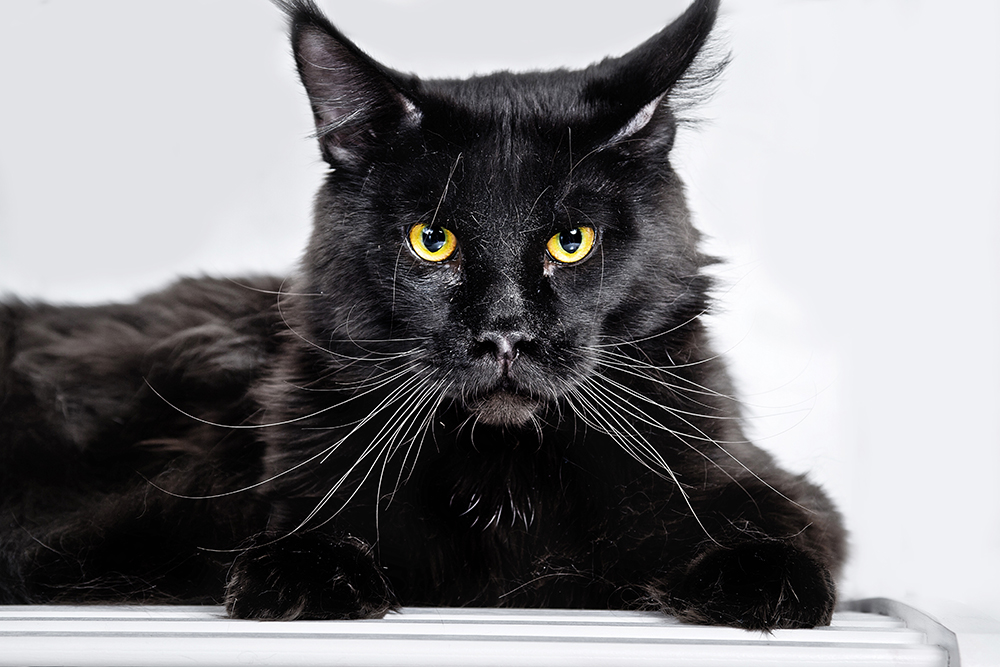Black cats are adorable creatures, but they are sometimes associated with witchcraft and bad luck. To make matters even more confusing, some civilizations worshipped and loved black cats long before their association with evil powers.
Even if you are a black cat aficionado, there are likely fascinating things that you don’t know about them. Read on for the top 10 interesting black cat facts!
Top 10 Black Cat Facts:
1. “Black Cat” Is Not a Breed
If you see a black cat, you only see the color of their fur, not their breed. “Black cat” is not a breed of cat. Instead, there are actually 22 recognized cat breeds that can have pitch-black coats.
Of these 22 breeds, the Bombay cat is the most popular. Despite their name, this cat is from Louisville, Kentucky, where they were bred to look like a mini black panther.

2. Most Black Cats Have Golden Eyes
Most people associate black cats with having bright yellow eyes. There is actually a scientific reason for this. Black coats are produced because the cat has more melanin, a pigment that contributes to the color of both skin and fur. This pigment also creates a rich amber eye, which explains why black cats often have this eye color.
3. Black Cats Are Sometimes Associated With Good Luck …
Believe it or not, there are some cultures that associate black cats with good luck. For example, German folklore believes that black cats can be good luck if one crosses in front of you, going from right to left.
Likewise, there are many cultures around the world that associate black cats with love and the ability to find a suitor. This is true for both Japanese and certain English traditions.

4. … But They Are Also Sometimes Associated With Bad Luck
Even though black cats can be associated with good luck, they are often associated with bad luck. This largely has to do with beliefs that stemmed from the Middle Ages. For example, black cats crossing your path from left to right are associated with bad luck instead of good luck.
5. Black Cats Resist More Diseases
Something that’s unique about black cats is that they have unique genetic mutations that help them to resist diseases. In fact, these mutations are similar to HIV resistance in humans.
Since these mutations are similar to mutative resistance in humans, researchers like to study black cats to learn how to prevent different diseases in humans as well.

6. Black Is the Most Dominant Color in Cats
Think back to biology class. Do you remember learning about dominant genes? Even if you don’t, that’s okay. Just know that in cats, the black coat color is the dominant gene. As a result, the tabby gene in the cat will be overridden by the black gene, resulting in a black cat.
Because black is the most dominant color, there are more black cats than any other color. This makes sense, given that the black coloration overrides all other colors.
7. Black Cats Can Change Color With the Sun
It is not uncommon for black cats to change color over time slightly. The reason for this is that their black coat can actually become bleached by the sun. When this happens, the dark black coat will turn into more of a rusty brown color.
This changing coloration happens whenever the sun breaks down the coat’s pigment, revealing the tabby stripes underneath. So, do not panic if your once-black cat has turned brown after lounging in the sun all summer.

8. Black Cats Are Tough to Photograph
Black cats can be notoriously difficult to photograph. Because of their dark colorations, they can just look like a black blob with no shape or structure. The cat must be photographed in perfect lighting against specific backdrops for them to be seen.
9. Black Cats Only Became Associated With Witchcraft in the Middle Ages
As you likely know, cats were worshipped by many ancient civilizations. Some gods and goddesses were even seen as having black cat heads. Unfortunately, this love of the cat did not remain.
The major shift against black cats happened during the Middle Ages. During this time, it was believed that black cats were in cohorts with witches and Satanists. This resulted in mass killings that still go on today.
In fact, the tradition is common enough that some animal shelters will not allow their black cats to be adopted during October. They fear that individuals will try to harm their black cats during this time.

10. Black Cats Are Celebrated on October 27
Luckily, black cats are not associated with witchcraft and Satanism as commonly today as they were in the Middle Ages. Instead, most people love black cats, which has even caused us to establish a National Black Cat Day, which falls on October 27.
Make sure to give your black cat the love they deserve whenever this day rolls around every year.
Tips for Owning Black Cats
If you are thinking about getting a black cat or own one already, here are some tips to keep in mind to make sure your cat is as happy as possible.
Understand Their Breed
As we learned, 22 different breeds that can have black coats. It’s important to know what breed you have so that you can look for specific health issues and grooming requirements based on your cat.

Grooming Is a Must
Black cats are loved because of their gorgeous coats. Make sure their coat stays healthy by grooming the cat. This will include brushing the coat based on its type. Long-haired cats will need to be brushed more frequently than short-haired ones.
Pay attention to the health of their skin, eyes, and paws as well. This will prevent any infections or problems impacting the cat’s beautiful coat and well-being.
Conclusion
As you can see, there’s a lot to know about black cats. Not only are they beautiful, but they also have a long history and open up a lot of conversations in the field of science.
Because of how amazing these cats are, black cats deserve all the love and attention of any other cat. Make sure to understand your black cat and groom them properly to ensure that they are healthy and happy in the long run.
See Also:
- 10 Ways Black Cats Bring Good Luck Around the World
- Black Cat Awareness Month: When Is It & How to Celebrate
Featured Image Credit By: Anna Krivitskaya, Shutterstock
Contents
- Top 10 Black Cat Facts:
- 1. “Black Cat” Is Not a Breed
- 2. Most Black Cats Have Golden Eyes
- 3. Black Cats Are Sometimes Associated With Good Luck …
- 4. … But They Are Also Sometimes Associated With Bad Luck
- 5. Black Cats Resist More Diseases
- 6. Black Is the Most Dominant Color in Cats
- 7. Black Cats Can Change Color With the Sun
- 8. Black Cats Are Tough to Photograph
- 9. Black Cats Only Became Associated With Witchcraft in the Middle Ages
- 10. Black Cats Are Celebrated on October 27
- Tips for Owning Black Cats
- Conclusion












